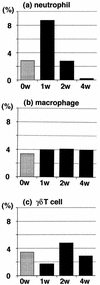Analysis of cytokines in the early development of gastric secondary lymphoid follicles in Helicobacter pylori-infected BALB/c mice with neonatal thymectomy
- PMID: 11598047
- PMCID: PMC100052
- DOI: 10.1128/IAI.69.11.6749-6754.2001
Analysis of cytokines in the early development of gastric secondary lymphoid follicles in Helicobacter pylori-infected BALB/c mice with neonatal thymectomy
Abstract
Immunological interaction between the host and Helicobacter pylori seems to play a critical role in follicular formation in gastric mucosa. We reported H. pylori-induced follicular gastritis model using neonatally thymectomized mice. In this study, we investigated the involvement of various cytokines in this model. BALB/c mice were thymectomized on the third day after birth (nTx). At 6 weeks old, these mice were orally infected with H. pylori. Histological studies showed that follicular formation occurred from 8 weeks after the infection and that most of the infiltrating lymphocytes were CD4(+) and B cells. Neutrophils increased transiently at 1 week after the infection. Gamma interferon, interleukin-7 (IL-7), and IL-7 receptor were expressed in the stomach of the nTx mice irrespective of the infection. In contrast, expressions of the tumor necrosis factor alpha, IL-4 and lymphotoxin-alpha genes were remarkably upregulated by the infection. Our findings suggest that follicular formation may require cooperative involvement of a Th2-type immune response, tumor necrosis factor alpha and lymphotoxin-alpha in addition to the Th1-type immune response in H. pylori-induced gastritis in nTx mice.
Figures



Similar articles
-
Involvement of myeloid dendritic cells in the development of gastric secondary lymphoid follicles in Helicobacter pylori-infected neonatally thymectomized BALB/c mice.Infect Immun. 2003 Apr;71(4):2153-62. doi: 10.1128/IAI.71.4.2153-2162.2003. Infect Immun. 2003. PMID: 12654837 Free PMC article.
-
Interaction of Helicobacter pylori-induced follicular gastritis and autoimmune gastritis in BALB/c mice with post-thymectomy autoimmune gastritis.J Gastroenterol. 2003;38(12):1131-7. doi: 10.1007/s00535-003-1219-3. J Gastroenterol. 2003. PMID: 14714249
-
Immunogenetic analysis of gastric MALT lymphoma-like lesions induced by Helicobacter pylori infection in neonatally thymectomized mice.Lab Invest. 2004 Apr;84(4):485-92. doi: 10.1038/labinvest.3700056. Lab Invest. 2004. PMID: 14968120
-
Mucosal immunization with a urease B DNA vaccine induces innate and cellular immune responses against Helicobacter pylori.Helicobacter. 2006 Apr;11(2):113-22. doi: 10.1111/j.1523-5378.2006.00385.x. Helicobacter. 2006. PMID: 16579841
-
Stomach microbiota, Helicobacter pylori, and group 2 innate lymphoid cells.Exp Mol Med. 2020 Sep;52(9):1377-1382. doi: 10.1038/s12276-020-00485-8. Epub 2020 Sep 10. Exp Mol Med. 2020. PMID: 32908209 Free PMC article. Review.
Cited by
-
Regulatory T cells may participate in Helicobacter pylori persistence in gastric MALT lymphoma: lessons from an animal model.Oncotarget. 2016 Jan 19;7(3):3394-402. doi: 10.18632/oncotarget.6492. Oncotarget. 2016. PMID: 26657504 Free PMC article.
-
Interferon-γ promotes gastric lymphoid follicle formation but not gastritis in Helicobacter-infected BALB/c mice.Gut Pathog. 2016 Nov 21;8:61. doi: 10.1186/s13099-016-0142-0. eCollection 2016. Gut Pathog. 2016. PMID: 27895717 Free PMC article.
-
Helicobacter pylori intragastric colonization and migration: Endoscopic manifestations and potential mechanisms.World J Gastroenterol. 2023 Aug 14;29(30):4616-4627. doi: 10.3748/wjg.v29.i30.4616. World J Gastroenterol. 2023. PMID: 37662858 Free PMC article. Review.
-
Involvement of myeloid dendritic cells in the development of gastric secondary lymphoid follicles in Helicobacter pylori-infected neonatally thymectomized BALB/c mice.Infect Immun. 2003 Apr;71(4):2153-62. doi: 10.1128/IAI.71.4.2153-2162.2003. Infect Immun. 2003. PMID: 12654837 Free PMC article.
-
Ectopic lymphoid tissues and local immunity.Semin Immunol. 2008 Feb;20(1):26-42. doi: 10.1016/j.smim.2007.12.004. Epub 2008 Feb 19. Semin Immunol. 2008. PMID: 18243731 Free PMC article. Review.
References
-
- Adachi S, Yoshida H K, Honda K, Maki K, Saijo K, Ikuta K, Saito T, Nishikawa S. Essential role of IL-7 receptor alpha in the formation of Peyer's patch anlage. Int Immunol. 1998;10:1–6. - PubMed
-
- Choe J, Kim H, Armitage R J, Choi Y S. The functional role of B cell antigen receptor stimulation and IL-4 in the generation of human memory B cells from germinal center B cells. J Immunol. 1997;159:3757–3766. - PubMed
-
- De Togni P D, Goellner J, Ruddle N H, Streeter P R, Fick A, Mariathasan S, Smith S C, Carlson R, Shornick L P, Strauss-Schoenberger J. Abnormal development of peripheral lymphoid organs in mice deficient in lymphotoxin. Science. 1994;264:703–707. - PubMed
-
- Dixon M F. Campylobacter pylori and chronic gastritis. In: Rathbone B J, Heatley R V, editors. Campylobacter pylori and gastroduodenal disease. Oxford, England: Blackwell Scientific; 1989. pp. 106–116.
Publication types
MeSH terms
Substances
LinkOut - more resources
Full Text Sources
Medical
Research Materials

